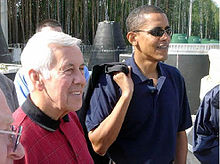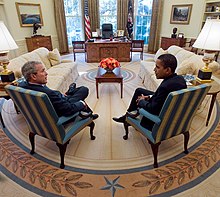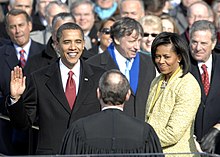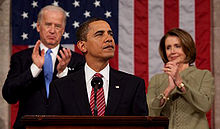Barack Hussein Obama II (i/bəˈrɑːk huːˈseɪn oʊˈbɑːmə/; born August 4, 1961) is the 44th and current President of the United States. He is the first African American to hold the office. Obama served as a U.S. Senator representing the state of Illinois from January 2005 to November 2008, when he resigned following his victory in the 2008 presidential election.
Born in Honolulu, Hawaii, Obama is a graduate of Columbia University and Harvard Law School, where he was the president of the Harvard Law Review. He was a community organizer in Chicago before earning his law degree. He worked as a civil rights attorney in Chicago and taught constitutional law at the University of Chicago Law School from 1992 to 2004. He served three terms representing the 13th District in the Illinois Senate from 1997 to 2004.
Following an unsuccessful bid against the Democratic incumbent for a seat in the United States House of Representatives in 2000, Obama ran for the United States Senate in 2004. Several events brought him to national attention during the campaign, including his victory in the March 2004 Illinois Democratic primary for the Senate election and his keynote address at the Democratic National Convention in July 2004. He won election to the U.S. Senate in Illinois in November 2004. His presidential campaign began in February 2007, and after a close campaign in the 2008 Democratic Party presidential primaries against Hillary Rodham Clinton, he won his party's nomination. In the 2008 presidential election, he defeated Republican nominee John McCain, and was inaugurated as president on January 20, 2009. Nine months later, Obama was named the 2009 Nobel Peace Prize laureate. In April 2011, he announced that he would be running for re-election in 2012.
As president, Obama signed economic stimulus legislation in the form of the American Recovery and Reinvestment Act of 2009 and the Tax Relief, Unemployment Insurance Reauthorization, and Job Creation Act of 2010 in response to the Late 2000s recession. Other major domestic policy initiatives include the Patient Protection and Affordable Care Act, the Dodd–Frank Wall Street Reform and Consumer Protection Act, the Don't Ask, Don't Tell Repeal Act of 2010, and the Budget Control Act of 2011. In foreign policy, Obama ended the Iraq War, increased troop levels in Afghanistan, signed theNew START arms control treaty with Russia, ordered U.S. military involvement in Libya, and ordered the military operation that resulted in the death of Osama bin Laden. In May 2012, he became the first sitting U.S. president to openly support legalizing same-sex marriage.
Early life and career
Main article: Early life and career of Barack Obama
Obama was born on August 4, 1961, at Kapiʻolani Maternity & Gynecological Hospital (now Kapiʻolani Medical Center for Women and Children) in Honolulu, Hawaii,[2][4][5] and is the first President to have been born in Hawaii.[6] His mother, Stanley Ann Dunham, was born in Wichita, Kansas, and was of mostly English ancestry,[7] along with Scottish, Irish, German, and Swiss.[8][9][10][11][12] His father,Barack Obama, Sr., was a Luo from Nyang’oma Kogelo, Nyanza Province, Kenya. Obama's parents met in 1960 in a Russian class at the University of Hawaiʻi at Mānoa, where his father was a foreign student on scholarship.[13][14] The couple married on February 2, 1961,[15] separated when Obama Sr. went to Harvard University on scholarship, and divorced in 1964.[13] Obama Sr. remarried and returned to Kenya, visiting Barack in Hawaii only once, in 1971. He died in an automobile accident in 1982.[16]
After her divorce, Dunham married Indonesian Lolo Soetoro, who was attending college in Hawaii. When Suharto, a military leader in Soetoro's home country, came to power in 1967, all Indonesian students studying abroad were recalled, and the family moved to the Menteng neighborhood of Jakarta.[4][17] From ages six to ten, Obama attended local schools in Jakarta, including Besuki Public School and St. Francis of Assisi School.[18]
In 1971, Obama returned to Honolulu to live with his maternal grandparents, Madelyn and Stanley Armour Dunham, and with the aid of a scholarship attendedPunahou School, a private college preparatory school, from fifth grade until his graduation from high school in 1979.[19] Obama's mother returned to Hawaii in 1972, remaining there until 1977 when she went back to Indonesia to work as an anthropological field worker. She finally returned to Hawaii in 1994 and lived there for one year before dying of ovarian cancer.[15][20]
Of his early childhood, Obama recalled, "That my father looked nothing like the people around me—that he was black as pitch, my mother white as milk—barely registered in my mind."[14] He described his struggles as a young adult to reconcile social perceptions of his multiracial heritage.[21] Reflecting later on his years in Honolulu, Obama wrote: "The opportunity that Hawaii offered—to experience a variety of cultures in a climate of mutual respect—became an integral part of my world view, and a basis for the values that I hold most dear."[22] Obama has also written and talked about using alcohol, marijuana, and cocaine during his teenage years to "push questions of who I was out of my mind."[23] At the 2008 Civil Forum on the Presidency, Obama described his high-school drug use as a great moral failure.[24]
Following high school, Obama moved to Los Angeles in 1979 to attend Occidental College. In February 1981, he made his first public speech, calling for Occidental to divest from South Africa in response to its policy of apartheid.[25] In mid-1981, Obama traveled to Indonesia to visit his mother and sister Maya, and visited the families of college friends in Pakistan and India for three weeks.[25] Later in 1981, he transferred to Columbia University in New York City, where he majored in political science with a specialty in international relations[26] and graduated with a Bachelor of Arts in 1983. He worked for a year at the Business International Corporation,[27] then at the New York Public Interest Research Group.[28][29]
Chicago community organizer and Harvard Law School
Two years after graduating, Obama was hired in Chicago as director of the Developing Communities Project (DCP), a church-based community organization originally comprising eight Catholic parishes in Roseland, West Pullman, and Riverdale on Chicago's South Side. He worked there as a community organizer from June 1985 to May 1988.[29][30] He helped set up a job training program, a college preparatory tutoring program, and a tenants' rights organization in Altgeld Gardens.[31] Obama also worked as a consultant and instructor for the Gamaliel Foundation, a community organizing institute.[32] In mid-1988, he traveled for the first time in Europe for three weeks and then for five weeks in Kenya, where he met many of his paternal relatives for the first time.[33][34] He returned to Kenya in 1992 with his fiancée Michelle and his sister Auma.[33][35] He returned to Kenya in August 2006 for a visit to his father's birthplace, a village near Kisumu in rural western Kenya.[36]
In late 1988, Obama entered Harvard Law School. He was selected as an editor of the Harvard Law Review at the end of his first year,[37] and president of the journal in his second year.[31][38] During his summers, he returned to Chicago, where he worked as an associate at the law firms of Sidley Austin in 1989 and Hopkins & Sutter in 1990.[39] After graduating with a J.D. magna cum laude[40] from Harvard in 1991, he returned to Chicago.[37] Obama's election as the first black president of theHarvard Law Review gained national media attention[31][38] and led to a publishing contract and advance for a book about race relations,[41] which evolved into a personal memoir. The manuscript was published in mid-1995 as Dreams from My Father.[41]
University of Chicago Law School and civil rights attorney
In 1991, Obama accepted a two-year position as Visiting Law and Government Fellow at the University of Chicago Law School to work on his first book.[41][42] He then taught at the University of Chicago Law School for twelve years—as a Lecturer from 1992 to 1996, and as a Senior Lecturer from 1996 to 2004—teaching constitutional law.[43]
From April to October 1992, Obama directed Illinois's Project Vote, a voter registration campaign with ten staffers and seven hundred volunteer registrars; it achieved its goal of registering 150,000 of 400,000 unregistered African Americans in the state, leading Crain's Chicago Business to name Obama to its 1993 list of "40 under Forty" powers to be.[44] In 1993, he joined Davis, Miner, Barnhill & Galland, a 13-attorney law firm specializing in civil rights litigation and neighborhood economic development, where he was an associate for three years from 1993 to 1996, then of counsel from 1996 to 2004. His law license became inactive in 2007.[45][46]
From 1994 to 2002, Obama served on the boards of directors of the Woods Fund of Chicago, which in 1985 had been the first foundation to fund the Developing Communities Project; and of the Joyce Foundation.[29] He served on the board of directors of the Chicago Annenberg Challenge from 1995 to 2002, as founding president and chairman of the board of directors from 1995 to 1999.[29]
Legislative career: 1997–2008
State Senator: 1997–2004
Main article: Illinois Senate career of Barack Obama
Obama was elected to the Illinois Senate in 1996, succeeding State Senator Alice Palmer as Senator from Illinois's 13th District, which at that time spanned Chicago South Side neighborhoods from Hyde Park – Kenwood south to South Shore and west to Chicago Lawn.[47] Once elected, Obama gained bipartisan support for legislation that reformed ethics and health care laws.[48] He sponsored a law that increased tax credits for low-income workers, negotiated welfare reform, and promoted increased subsidies for childcare.[49] In 2001, as co-chairman of the bipartisan Joint Committee on Administrative Rules, Obama supported Republican Governor Ryan's payday loan regulations and predatory mortgage lending regulations aimed at averting home foreclosures.[50]
Obama was reelected to the Illinois Senate in 1998, defeating Republican Yesse Yehudah in the general election, and was reelected again in 2002.[51] In 2000, he lost a Democratic primary race for Illinois's 1st congressional district in the United States House of Representatives to four-term incumbent Bobby Rush by a margin of two to one.[52]
In January 2003, Obama became chairman of the Illinois Senate's Health and Human Services Committee when Democrats, after a decade in the minority, regained a majority.[53] He sponsored and led unanimous, bipartisan passage of legislation to monitor racial profiling by requiring police to record the race of drivers they detained, and legislation making Illinois the first state to mandate videotaping of homicide interrogations.[49][54] During his 2004 general election campaign for U.S. Senate, police representatives credited Obama for his active engagement with police organizations in enacting death penalty reforms.[55] Obama resigned from the Illinois Senate in November 2004 following his election to the U.S. Senate.[56]
U.S. Senate campaign
In May 2002, Obama commissioned a poll to assess his prospects in a 2004 U.S. Senate race; he created a campaign committee, began raising funds, and lined up political media consultant David Axelrod by August 2002. Obama formally announced his candidacy in January 2003.[57]
Obama was an early opponent of the George W. Bush administration's 2003 invasion of Iraq.[58] On October 2, 2002, the day President Bush and Congress agreed on the joint resolution authorizing the Iraq War,[59]Obama addressed the first high-profile Chicago anti-Iraq War rally,[60] and spoke out against the war.[61] He addressed another anti-war rally in March 2003 and told the crowd that "it's not too late" to stop the war.[62]
Decisions by Republican incumbent Peter Fitzgerald and his Democratic predecessor Carol Moseley Braun to not participate in the election resulted in wide-open Democratic and Republican primary contests involving fifteen candidates.[63] In the March 2004 primary election, Obama won in an unexpected landslide—which overnight made him a rising star within the national Democratic Party, started speculation about a presidential future, and led to the reissue of his memoir, Dreams from My Father.[64] In July 2004, Obama delivered the keynote address at the 2004 Democratic National Convention,[65] seen by 9.1 million viewers. His speech was well received and elevated his status within the Democratic Party.[66]
Obama's expected opponent in the general election, Republican primary winner Jack Ryan, withdrew from the race in June 2004.[67] Six weeks later, Alan Keyes accepted the Republican nomination to replace Ryan.[68] In the November 2004 general election, Obama won with 70 percent of the vote.[69]
U.S. Senator: 2005–2008
Main article: United States Senate career of Barack Obama
Obama was sworn in as a senator on January 3, 2005,[70] becoming the only Senate member of the Congressional Black Caucus.[71] CQ Weekly characterized him as a "loyal Democrat" based on analysis of all Senate votes in 2005–2007. Obama announced on November 13, 2008, that he would resign his Senate seat on November 16, 2008, before the start of the lame-duck session, to focus on his transition period for the presidency.[72]
Legislation
Obama cosponsored the Secure America and Orderly Immigration Act.[73] He introduced two initiatives that bore his name: Lugar–Obama, which expanded the Nunn–Lugar cooperative threat reduction concept to conventional weapons;[74] and theFederal Funding Accountability and Transparency Act of 2006, which authorized the establishment of USAspending.gov, a web search engine on federal spending.[75] On June 3, 2008, Senator Obama—along with Senators Tom Carper, Tom Coburn, and John McCain—introduced follow-up legislation: Strengthening Transparency and Accountability in Federal Spending Act of 2008.[76]
Obama sponsored legislation that would have required nuclear plant owners to notify state and local authorities of radioactive leaks, but the bill failed to pass in the full Senate after being heavily modified in committee.[77] Regarding tort reform, Obama voted for the Class Action Fairness Act of 2005 and the FISA Amendments Act of 2008, which grants immunity from civil liability to telecommunications companies complicit with NSA warrantless wiretapping operations.[78]
In December 2006, President Bush signed into law the Democratic Republic of the Congo Relief, Security, and Democracy Promotion Act, marking the first federal legislation to be enacted with Obama as its primary sponsor.[80] In January 2007, Obama and Senator Feingold introduced a corporate jet provision to the Honest Leadership and Open Government Act, which was signed into law in September 2007.[81]Obama also introduced Deceptive Practices and Voter Intimidation Prevention Act, a bill to criminalize deceptive practices in federal elections,[82] and the Iraq War De-Escalation Act of 2007,[83] neither of which was signed into law.
Later in 2007, Obama sponsored an amendment to the Defense Authorization Act to add safeguards for personality-disorder military discharges.[84] This amendment passed the full Senate in the spring of 2008.[85] He sponsored the Iran Sanctions Enabling Act supporting divestment of state pension funds from Iran's oil and gas industry, which has not passed committee; and co-sponsored legislation to reduce risks of nuclear terrorism.[86] Obama also sponsored a Senate amendment to the State Children's Health Insurance Program, providing one year of job protection for family members caring for soldiers with combat-related injuries.[87]
Committees
Obama held assignments on the Senate Committees for Foreign Relations, Environment and Public Works, and Veterans' Affairs through December 2006.[88] In January 2007, he left the Environment and Public Works committee and took additional assignments with Health, Education, Labor, and Pensions and Homeland Security and Governmental Affairs.[89] He also became Chairman of the Senate's subcommittee on European Affairs.[90] As a member of the Senate Foreign Relations Committee, Obama made official trips to Eastern Europe, the Middle East, Central Asia and Africa. He met withMahmoud Abbas before Abbas became President of the Palestinian National Authority, and gave a speech at the University of Nairobi in which he condemned corruption within the Kenyan government.[91]
Presidential campaigns
2008 presidential campaign
Main articles: United States presidential election, 2008, Barack Obama presidential primary campaign, 2008, and Barack Obama presidential campaign, 2008
On February 10, 2007, Obama announced his candidacy for President of the United States in front of the Old State Capitol building in Springfield, Illinois.[92][93] The choice of the announcement site was viewed as symbolic because it was also where Abraham Lincoln delivered his historic "House Divided" speech in 1858.[92][94] Obama emphasized issues of rapidly ending the Iraq War, increasing energy independence, and providing universal health care,[95] in a campaign that projected themes of "hope" and "change".[96]
A large number of candidates entered the Democratic Party presidential primaries. The field narrowed to a duel between Obama and Senator Hillary Rodham Clinton after early contests, with the race remaining close throughout the primary process but with Obama gaining a steady lead in pledged delegates due to better long-range planning, superior fundraising, dominant organizing in caucus states, and better exploitation of delegate allocation rules.[97] On June 7, 2008, Clinton ended her campaign and endorsed Obama.[98]
On August 23, Obama announced his selection of Delaware Senator Joe Biden as his vice presidential running mate.[99] Biden was selected from a field speculated to include former Indiana Governor and Senator Evan Bayh and Virginia Governor Tim Kaine.[100] At the Democratic National Convention in Denver, Colorado, Hillary Clinton called for her supporters to endorse Obama, and she and Bill Clinton gave convention speeches in his support.[101] Obama delivered his acceptance speech, not at the center where the Democratic National Convention was held, but at Invesco Field at Mile High to a crowd of over 75,000; the speech was viewed by over 38 million people worldwide.[102][103]
During both the primary process and the general election, Obama's campaign set numerous fundraising records, particularly in the quantity of small donations.[104] On June 19, 2008, Obama became the first major-party presidential candidate to turn down public financing in the general election since the system was created in 1976.[105]
John McCain was nominated as the Republican candidate and the two engaged in three presidential debates in September and October 2008.[106] On November 4, Obama won the presidency with 365electoral votes to 173 received by McCain.[107] Obama won 52.9% of the popular vote to McCain's 45.7%.[108] He became the first African American to be elected president.[109] Obama delivered his victory speech before hundreds of thousands of supporters in Chicago's Grant Park.[110]
2012 presidential campaign
Main articles: United States presidential election, 2012 and Barack Obama presidential campaign, 2012
On April 4, 2011, Obama announced his re-election campaign for 2012 in a video titled "It Begins with Us" that he posted on his website and filed election papers with the Federal Election Commission.[111][112][113] As the incumbent president he ran almost unopposed in the Democratic Party presidential primaries,[114] and on April 3, 2012, Obama had secured the 2778 convention delegates needed to win the Democratic nomination.[115]
Presidency
Main article: Presidency of Barack Obama
See also: Confirmations of Barack Obama's Cabinet and List of presidential trips made by Barack Obama
First days
The inauguration of Barack Obama as the 44th President, and Joe Biden as Vice President, took place on January 20, 2009. In his first few days in office, Obama issued executive orders and presidential memoranda directing the U.S. military to develop plans to withdraw troops from Iraq.[116] He ordered the closing of the Guantanamo Bay detention camp,[117] but Congress prevented the closure by refusing to appropriate the required funds.[118][119][120] Obama reduced the secrecy given to presidential records,[121] and changed procedures to promote disclosure under the Freedom of Information Act.[122] He also reversed George W. Bush's ban on federal funding to foreign establishments that allow abortions.[123]
Domestic policy
Main article: Barack Obama social policy
The first bill signed into law by Obama was the Lilly Ledbetter Fair Pay Act of 2009, relaxing the statute of limitations for equal-pay lawsuits.[124] Five days later, he signed the reauthorization of the State Children's Health Insurance Program (SCHIP) to cover an additional 4 million uninsured children.[125] In March 2009, Obama reversed a Bush-era policy which had limited funding of embryonic stem cellresearch and pledged to develop "strict guidelines" on the research.[126]
Obama appointed two women to serve on the Supreme Court in the first two years of his Presidency. Sonia Sotomayor, nominated by Obama on May 26, 2009, to replace retiring Associate Justice David Souter, was confirmed on August 6, 2009,[127] becoming the first Hispanic Supreme Court Justice.[128] Elena Kagan, nominated by Obama on May 10, 2010, to replace retiring Associate Justice John Paul Stevens, was confirmed on August 5, 2010, bringing the number of women sitting simultaneously on the Court to three, for the first time in American history.[129]
On September 30, 2009, the Obama administration proposed new regulations on power plants, factories and oil refineries in an attempt to limit greenhouse gas emissions and to curb global warming.[130][131]
On October 8, 2009, Obama signed the Matthew Shepard and James Byrd, Jr. Hate Crimes Prevention Act, a measure that expands the 1969 United States federal hate-crime law to include crimes motivated by a victim's actual or perceived gender, sexual orientation, gender identity, or disability.[132][133]
On March 30, 2010, Obama signed the Health Care and Education Reconciliation Act, a reconciliation bill which ends the process of the federal government giving subsidies to private banks to give out federally insured loans, increases the Pell Grant scholarship award, and makes changes to the Patient Protection and Affordable Care Act.[134][135]
In a major space policy speech in April 2010, Obama announced a planned change in direction at NASA, the U.S. space agency. He ended plans for a return of human spaceflight to the moon and development of the Ares I rocket, Ares V rocket and Constellation program, in favor of funding Earth science projects, a new rocket type, and research and development for an eventual manned mission toMars, and ongoing missions to the International Space Station.[136]
On December 22, 2010, Obama signed the Don't Ask, Don't Tell Repeal Act of 2010, fulfilling a key promise made in the 2008 presidential campaign[137][138] to end the Don't ask, don't tell policy of 1993 that had prevented gay and lesbian people from serving openly in the United States Armed Forces.[139]
President Obama's 2011 State of the Union Address focused on themes of education and innovation, stressing the importance of innovation economics to make the United States more competitive globally. He spoke of a five-year freeze in domestic spending, eliminating tax breaks for oil companies and reversing tax cuts for the wealthiest Americans, banning congressional earmarks, and reducing healthcare costs. He promised that the United States would have one million electric vehicles on the road by 2015 and would be 80% reliant on "clean" electricity.[140][141]
As a candidate for the Illinois state senate Obama had said in 1996 that he favored legalizing same-sex marriage;[142] but by the time of his run for the U.S. senate in 2004, he said that while he supported civil unions and domestic partnerships for same-sex partners, for strategic reasons he opposed same-sex marriages.[143] On May 9, 2012, shortly after the official launch of his campaign for re-election as president, Obama said his views had evolved, and he publicly affirmed his personal support for the legalization of same-sex marriage, becoming the first sitting U.S. president to do so.[144][145]








No comments:
Post a Comment